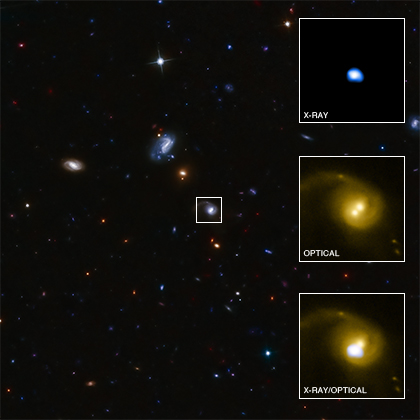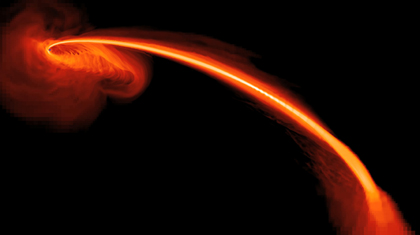Submitted by chandra on Fri, 2012-06-01 19:39
For more context on CID-42 and the science of black hole kicks, we interviewed Professor Abraham (Avi) Loeb, one of the co-authors of the new paper. Avi is the director of the Institute for Theory and Computation, within the Harvard-Smithsonian Center for Astrophysics, and he is currently serving as Chair of the Department of Astronomy at Harvard University. He was recently elected to become a member of the American Academy of Arts & Sciences. Avi has worked on a wide variety of topics in astrophysics, including cosmology, black holes, gravitational lensing by planets and gamma-ray bursts in the distant Universe.

Q: How significant do you think this result is?
A: CID-42 is the best candidate for a massive black hole that might have been kicked out of the center of a galaxy with a high speed. An interesting mechanism for obtaining such a kick involves the merger of two black holes into the kicked black hole.
Submitted by chandra on Thu, 2012-05-31 09:24
Following the success of our first poetry competition last year, Chandra X-ray Observatory and Jonathan Taylor, Senior Lecturer in Creative Writing, have run a second competition, in which Creative Writing students at De Montfort University in the U.K. were invited to write poems inspired by some of Chandra’s findings and research areas. For the first installment, two out of the four winning entries are shown below (See also part two). All of the entries explore, in their different ways, the overlap between poetry and scientific discovery. Congratulations to the winners and everyone involved for making this unique competition possible.
You can read other student poems inspired by Chandra here and here. Jonathan Taylor's own three poems for Chandra include:
Black Hole in B-Flat
History Lesson
!!**&@??
Nickname GRS 1915
embracing
the evaporating definitions
of space and time
blurred
like the disk clothing me
matter
in a fight
of gravitation
and radiation
Submitted by chandra on Tue, 2012-05-29 16:07
Welcome to the latest edition of the Carnival of Space!
Not surprisingly, we had folks talking about Space X making history by being the first private company to launch a mission to the International Space Station. Read the take over at Dear Astronomer.
Submitted by chandra on Thu, 2012-05-24 08:53

This image of the Pinwheel Galaxy, or also known as M101, combines data in the infrared, visible, ultraviolet and X-rays from four of NASA's space-based telescopes. This multi-spectral view shows that both young and old stars are evenly distributed along M101's tightly-wound spiral arms. Such composite images allow astronomers to see how features in one part of the spectrum match up with those seen in other parts. It is like seeing with a regular camera, an ultraviolet camera, night-vision goggles and X-ray vision, all at the same time.
Submitted by chandra on Wed, 2012-05-23 10:05
What has Chandra found (or not found) during the course of its mission in the important area of exploded stars and what they leave behind? Find out in this post in "The Unexpected" series.
Expected and Detected:
As anticipated, high-resolution X-ray images have provided new insight into the supernova process, the effect supernova shock waves have on the surrounding interstellar gas, the acceleration of particles by rotating neutron stars, and enabled the discovery of many stellar-mass black holes.
More information:
http://www.chandra.harvard.edu/photo/2009/crab/
Submitted by chandra on Wed, 2012-05-16 14:14
We have refreshed the Chandra web site to a content "portal" format. Let us know what you think about the changes http://chandra.si.edu
Submitted by chandra on Tue, 2012-05-15 10:15

Observations with NASA's Chandra X-ray Observatory have provided the first X-ray evidence of a supernova shock wave breaking through a cocoon of gas surrounding the star that exploded. This discovery may help astronomers understand why some supernovas are much more powerful than others.
Submitted by chandra on Wed, 2012-05-09 19:00

A new study has shown that galaxies with the most powerful, active, supermassive black holes at their cores produce fewer stars than galaxies with less active black holes. Researchers compared infrared readings from the Hershel Space Observatory with X-rays streaming from the active central black holes in a survey of 65 galaxies, measured by NASA's Chandra X-ray Observatory.
Submitted by chandra on Tue, 2012-05-08 14:01
Here's our next installation in our occasional series on the Chandra blog called "The Unexpected." These posts will take a look at some of the biggest surprises (and expected discoveries) made by Chandra so far in its mission. Today's topic is "normal stars," which is what astronomers call stars that are similar to our Sun.
Expected and Detected:
X-ray emission from the outer atmospheres, or coronas, of stars of almost every type: young and old, large and small.
Submitted by chandra on Thu, 2012-05-03 10:22

This computer-simulated image shows gas from a star that is ripped apart by tidal forces as it falls into a black hole. Some of the gas also is being ejected at high speeds into space.
Pages